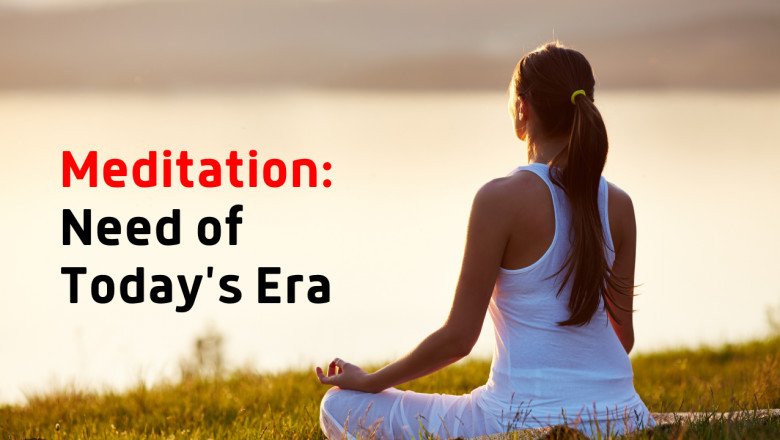views

Meditation: Need of Today's Era!!
Meditation is a practice in which an individual uses a technique – such as mindfulness, or focusing the mind on a particular object, thought, or activity – to train attention and awareness, and achieve a mentally clear and emotionally calm and stable state. Meditation has been practiced for thousands of years in many different cultures, and it has been shown to have a number of benefits, including reducing stress and anxiety, improving focus and concentration, and increasing feelings of calm and relaxation. There are many different types of meditation that are being practiced in many Best Ayurveda Wellness Centers, and people may use different techniques to practice, such as mindful breathing, visualization, or repeating a mantra. Some people meditate as part of a spiritual or religious practice, while others do it for mental and physical benefits.
Types of Mediation
There are many types of meditation, and some common ones include:
-
Mantra Meditation: Mantra meditation is a type of meditation in which you repeat a specific word or phrase, known as a mantra, to help you focus your attention and quiet your mind. The repetition of the mantra can help you let go of distracting thoughts and emotions and reach a state of relaxation and calm. You can go and learn this type of meditation in some of the best meditation centers to make your stressed mind peaceful. Some people believe that the vibrations created by repeating the mantra can also have physical and psychological benefits.
To practice mantra meditation, you can sit in a comfortable position and close your eyes. Take a few deep breaths and then begin repeating the mantra to yourself, either out loud or silently in your mind. You can repeat the mantra as many times as you like, and if you get distracted by other thoughts, gently redirect your attention back to the mantra. Some people find it helpful to set a specific time for their meditation practice, while others prefer to meditate for as long as they feel comfortable.
-
Transcendental Meditation: Transcendental Meditation (TM) is a specific type of meditation practice that involves the use of a mantra. It was developed by Maharishi Mahesh Yogi and has been taught to millions of people around the world.
During Transcendental Meditation, you sit comfortably with your eyes closed and repeat a mantra to yourself for about 20 minutes. The mantra is a specific sound that is chosen for you during a TM training program. The idea is that the repetition of the mantra will help you settle into a state of deep relaxation and inner calm.
Proponents of Transcendental Meditation claim that it can reduce stress, improve mental clarity, and promote physical health. Some studies have found that it can be effective for reducing anxiety and high blood pressure, and improving cardiovascular health. However, more research is needed to fully understand the potential benefits of TM.
-
Progressive relaxation: Progressive relaxation is a technique that involves tensing and relaxing different muscle groups in the body to help you relax and reduce stress. It is often used as a relaxation technique in conjunction with other practices such as meditation or mindfulness.
To practice progressive relaxation, you can lie down or sit in a comfortable position and close your eyes. Starting with your feet, tense the muscles in that part of your body for a few seconds, and then relax them. Move on to the muscles in your calves, thighs, and so on, working your way up your body. As you tense and relax each muscle group, take deep breaths and focus on the sensation of the muscles relaxing.
Progressive relaxation can help you feel more relaxed and reduce muscle tension. It may also help you sleep better and improve your overall sense of well-being.
-
Trataka Meditation: Trataka meditation is a type of meditation that involves focusing on a single point, such as a candle flame or a geometric shape, with an unwavering gaze. It is a form of concentration meditation that is meant to help quiet the mind and improve focus and clarity.
To practice Trataka meditation, you can sit in a comfortable position with your spine straight and your eyes open. Hold your gaze on a single point, such as a candle flame or a black dot on a white piece of paper, without blinking or looking away. If your mind wanders, gently redirect your attention back to the point of focus. You can practice Trataka meditation for as long as you feel comfortable, although some people find it helpful to set a specific time.
Trataka meditation is said to improve eye health and vision, and it may also help to calm the mind and reduce stress. It can be a challenging practice, as it requires a great deal of focus and discipline. However, with regular practice, it can be a powerful tool for improving concentration and inner calm.
-
Pranic Energisation Treatment: Pranic Healing is a form of energy healing that is based on the belief that the body has a "life force" or "prana" that can be manipulated to improve physical and emotional health. Pranic Energisation Treatment (PET) is a specific technique within the broader practice of Pranic Healing that involves using the hands to transfer energy to certain parts of the body.
To practice PET, the practitioner begins by placing their hands over specific areas of the client's body, such as the head or the chest. The practitioner then uses their intention to transfer energy to the client, with the goal of balancing the body's energy and promoting healing. PET is said to be particularly effective for relieving stress and anxiety, and for helping to improve physical and emotional well-being.
It is important to note that the effectiveness of Pranic Healing and PET has not been scientifically established, and these practices should not be used as a replacement for medical treatment.
-
Mind Sound Resonance Technique: Mind Sound Resonance Technique (MSRT) is a type of meditation that involves listening to specific sound frequencies with the goal of achieving a state of deep relaxation and inner peace. It is based on the belief that different sound frequencies can have specific effects on the body and the mind, and that by listening to certain frequencies, it is possible to bring about positive changes in the body and the brain.
To practice MSRT, you will need to listen to a recording of specific sound frequencies through headphones or speakers. The frequencies are typically in the form of binaural beats, which are two slightly different sound frequencies that are played into each ear separately. The idea is that the brain will interpret the difference between the two frequencies and create a third, internal frequency that is the difference between the two. This internal frequency is said to have a specific effect on the brain and the body, depending on the frequencies that are used.
It is important to note that the effectiveness of MSRT has not been scientifically established, and it should not be used as a replacement for medical treatment.
-
Yoga Nidra: Yoga Nidra, also known as "yogic sleep," is a state of consciousness between waking and sleeping. It is a relaxation technique that is often used in conjunction with yoga practice, but it can also be practiced on its own.
During Yoga Nidra, you lie down in a comfortable position and are guided through a series of mental and physical relaxation techniques. This may include focusing on your breath, relaxing different parts of your body, and visualizing peaceful images or experiences. The goal is to reach a state of deep relaxation and inner calm, and to release any physical or mental tension.
Yoga Nidra is said to have a number of benefits, including reducing stress and anxiety, improving sleep, and promoting overall well-being. It is a gentle and relaxing practice that can be easily incorporated into a daily routine.
-
Twin Heart Meditation: Twin Heart Meditation is a spiritual practice that is based on the belief that the heart has a higher spiritual function in addition to its physical function as a pump for the circulatory system. The practice involves focusing on the energy in the heart and the crown chakra, which is believed to be the energy center at the top of the head.
To practice Twin Heart Meditation, you will need to sit in a comfortable position with your spine straight. Begin by focusing your attention on the energy in your heart and visualizing a bright, glowing light in the center of your chest. You can then shift your focus to the crown chakra at the top of your head, and visualize a similar glowing light there. As you focus on these two energy centers, you can visualize a flow of energy between them.
Twin Heart Meditation is said to bring about a sense of peace and inner clarity, and to promote feelings of compassion and loving-kindness. It is often practiced as a means of developing a stronger connection with the divine and increasing spiritual awareness.
-
Sohum Meditation: Sohum meditation is a type of meditation that involves repeating the sound "sohum" to oneself as a mantra. The word "sohum" is believed to be the sound of the breath and the sound of the universe, and is thought to connect the individual with the divine.
To practice Sohum meditation, you can sit in a comfortable position with your eyes closed and focus on your breath. As you inhale, silently repeat the sound "so" to yourself, and as you exhale, silently repeat the sound "hum." You can continue this repetition for as long as you feel comfortable, allowing the mantra to carry you into a state of relaxation and inner calm.
Sohum meditation is said to help quiet the mind and bring about a sense of inner peace and clarity. It is often used as a tool for stress reduction and for cultivating a deeper sense of connection with the divine.
-
Chakra meditation: Chakra meditation is a type of meditation that involves focusing on the energy centers of the body known as chakras. There are seven main chakras in the body, and each is associated with specific physical and emotional characteristics.
To practice chakra meditation, you can sit in a comfortable position and close your eyes. Begin by focusing your attention on the base of your spine, which is the location of the root chakra. Visualize a spinning wheel of energy at this point and focus on the qualities associated with the root chakra, such as stability and a sense of belonging.
Next, move your focus to the sacral chakra, which is located in the lower abdomen. Visualize a spinning wheel of energy here and focus on the qualities associated with the sacral chakra, such as creativity and sexuality. Continue this process, moving up through the remaining chakras and focusing on their associated qualities.
Chakra meditation is said to help balance the energy in the body and bring about a sense of harmony and well-being. It may also help to improve physical and emotional health.
Why is meditation important in this era?
Meditation has been practiced for thousands of years and is still popular today because it has a number of potential benefits for both physical and mental health and now in this modern time, there are ayurvedic wellness centers where people can go and practice it. Some of the reasons why meditation may be essential in today's world include:
-
Stress reduction: Meditation has been shown to be effective in reducing stress and anxiety. In today's fast-paced world, many people are struggling with high levels of stress, and meditation can be a useful tool for coping with this.
-
Improved mental clarity: Meditation can help to quiet the mind and improve focus and concentration. This can be especially important in an era where there are many distractions and it can be hard to stay present and focused.
-
Physical health benefits: Meditation has been linked to a number of physical health benefits, including lower blood pressure, improved cardiovascular health, and better sleep.
-
Increased self-awareness: Meditation can help to increase self-awareness and promote a sense of inner peace and clarity. This can be especially important in a world where people often feel disconnected from themselves.
Conclusion:
In today's fast-paced and often stressful world, meditation can be particularly helpful in helping people to manage their emotions and find balance in their lives. Some people use meditation as a way to relax and unwind after a busy day, while others use it as a way to manage stress and improve their mental health. Meditation can also be beneficial for people who are seeking to improve their focus and concentration, as it helps to train the mind to be more present and aware. Many Ayurvedic Wellness Centers help people to practice meditation so that they can reduce their stress and feel more relaxed. As a matter of fact, meditation is a beneficial and helpful practice that can improve both one's physical and mental health, and anyone can benefit from its practice.











